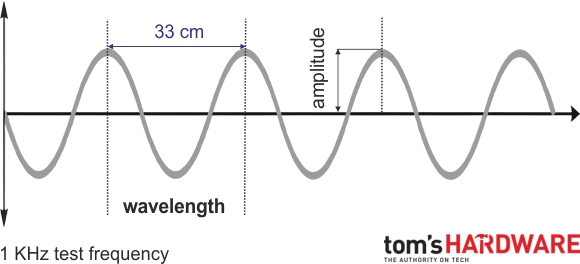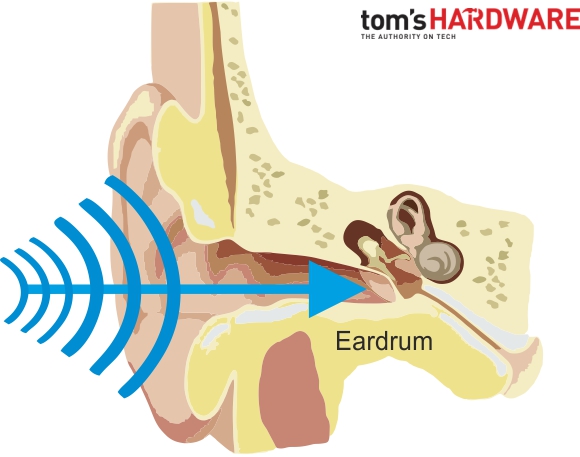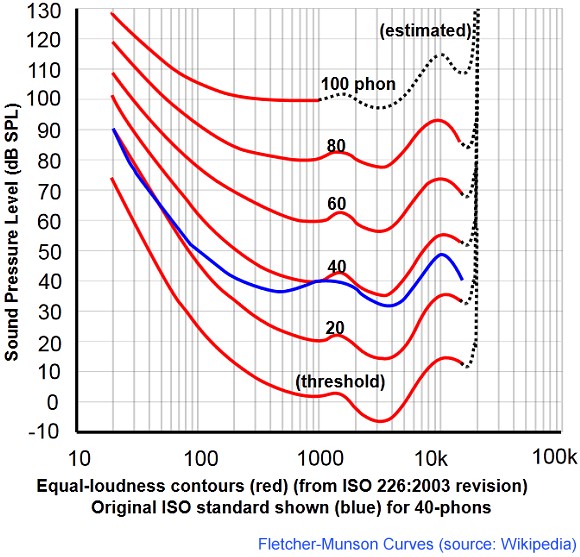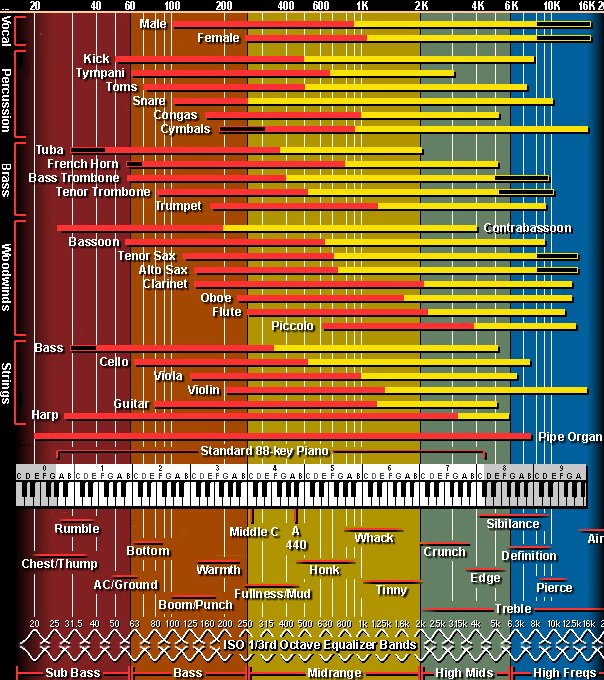Of sound, waves and lengths

The focus is on airborne sound, which is exactly what takes place between the sound source and the human ear. We want to create this sound with our test objects and hear it with our own ears. But since a lot can happen along the way (and also in the forwarding of the information up to the brain), we first look at the sound waves and then go step by step.
We quickly remember the physics lessons and the fact that sound is a purely mechanical vibration process, which, depending on the respective medium (in our case air), has a certain speed (air approx. 330 to 340 m/s). This speed of sound is also influenced by factors such as humidity and temperature, but for the sake of simplicity we do not want to take this into account at this point.

Much more interesting for us is the fact that it is a vibration that spreads wave-like in space. Depending on the height of a sound, such a sound wave has a very special wavelength. By the way, this wavelength can be calculated quite easily, because we only divide the speed of sound by the frequency. With a test signal of one kilohertz (i.e. 1000 vibrations/s) and the speed of sound of 330 m/s, this would result in 330 m divided by 1000. The wavelength is thus 33 cm (0.33 m). At 100 Hz it would already be 3.30 m, at 30 Hz then almost 10 m!
As we hear: The eardrum
The sound hits our ear and penetrates through the ear canal to the eardrum. Let’s simplify the whole thing a bit and remember the test frequency of one kilohertz. This sinusoidal sound is nothing more than a kind of pressure wave that hits the eardrum. This pressure applied to the eardrum changes periodically within the respective frequency (see above curve), because the sound only hits the eardrum from one side.
What we can now “hear” is this difference between the sound pressure and the constantly acting air pressure, which is usually the same on both sides of the eardrum and rises. These differences are only a few millionths of a bar, while the average normal air pressure in normal weather at sea level is 1000 mBar. In this way, we also notice how sensitive our ear actually is.
Unfortunately, our ear is a little limited in the frequency range, whereby one can assume on average an audible range of 16 Hz to about 16 kHz. Depending on age, this range can also be slightly lower, especially with the higher tones.

The physiology of the ear
We now have to deal briefly with a specific feature of the human ear. Imagine sitting in a concert hall where an orchestra plays and listening in the loudest places with up to 100 phons (subjectively perceived volume). At the same time, a sound recording of the concerto takes place, which is mixed exactly as we can almost perceive it in the first row.
We then later acquire exactly this recording as a CD and find disappointment when playing that the sound impression in the home four walls and in the headphones is completely different. This is due to our ear, which strongly influences the subjective volume perception depending on the frequency and actual sound level. So the human ear is not a linear, let alone an ideal transducer!

The frequency-dependent volume sensation would be analyzed by Fletcher-Munson in the early 1933s and presented for the first time in curve form. It can be seen very clearly that a greatly reduced volume impression is created, especially at low frequencies with a decreasing sound level. Certain high-frequency ranges are also affected by this natural peculiarity of human hearing. As a result, the “audible” or “physiological” volume correction can still be found today. also loudness function) on various amplifiers and active boxes, whereby such a thing must always be viewed with a certain suspicion.
We note first of all that the much-praised “linearity” in the overall sequence does not exist without a very high sound level, since one’s own ear is always the weakest chain in the limb!
Another circumstance is the different attenuation of different frequencies in relation to the distance and angle to the sound source. What hits our ears from the sound source in the shortest possible and direct way is called direct sound. However, since the sound (similar to light) spreads wave-like and the drivers of course do not radiate only in a single direction, so-called reflections occur: the sound hits the earcup, for example, and becomes similar to the billiards ( attenuated) is discarded.
The space between the transducer and the ear is in fact our listening room with closed and semi-open systems and we now also understand how different materials, shapes and upholstery can distort the sound very noticeably.
Sound event and hearing event
A little bit we have to torment the reader now, so that he understands later also why each person perceives certain sound events differently. Even if a very specific sound source produces an always identical sound event (i.e. a piece of music plays in an endless loop), then every person perceives it subjectively completely differently.
In contrast to this so-called sound event, the subjective hearing event is shaped spatially, temporally and in terms of character. The relationship between sound event (irritation) and hearing event (sensation) is a very complex matter; both cannot be equated directly.
Too complicated? Let’s see what lies behind it in detail and compare the real sound event (measurable values) with our subjectively perceived hearing event (tangible impressions):
| Sound event | Hearing event |
|---|---|
| Noise level | Loudness (Phon) |
| Frequency | Tone (Mel) |
| Acoustic spectrum | Sound |
| Position of the sound source(s) | Localization of the sound source or Hearing event direction |
We already know some of these terms; we have already informed ourselves about the sound pressure level, the frequency and the acoustic spectrum of the complex sound image as a mixture of different frequencies. Now there is the position of the sound source and what all four individual components have in total for an effect.
Frequency ranges and subjective hearing impression
First of all, let us explain how we divide the individual frequency ranges for our evaluation and why this individual evaluation is more important than simply listening to a few titles. In addition, the assessment of spatial mapping, level strength and technical aspects is added separately later.
If you analyze exactly which frequency ranges can be played back on a device, how good or bad, you can almost certainly conclude from it its general performance, which you can expect in total for the entire frequency spectrum.
For this purpose, we are also happy to link to the interactive display of independentrecording.net (IRN), which provides a good overview of the individual frequency ranges and their most important representatives and sound sources. Simply click on the static preview image or the text link!
We can see that from the low bass to the high tone, all frequency ranges are quite well occupied. In the following, we present our table of the most important areas by which we subjectively evaluate our headsets and headphones.
| Category |
Frequency range |
Description |
|---|---|---|
| Low bass: | 16 to 32 Hz | This area of subcontraoctave is only reached by very few instruments, but can be particularly important in classical music. Only a few of the speakers we usually test are able to reproduce this area completely or at least in part. |
| Low bass: |
32 to 64 Hz | In the contraoctave (32.7 to 65.4 Hz) there are already many interesting instruments as well as the effect track of neatly mixed Dolby soundscapes of movies (so-called track 0) and certain effects in games. Whether extremely deeply tuned bass guitars, earthquakes, detonation or large bass drum for the dancers – without deep bass everything sounds a little flat. |
| Bass and upper bass: |
64 to 150 Hz | The upper bass up to 150 Hz, in which also the Great Octave (65.4 to 130.8 Hz) is located, houses the basic language frequency of the male voice and decides very strongly on the true-to-life reproduction of male vocals. Here we mainly examine the reproduction of good male vocals as well as the harmonization of different vocal positions including the location of individual sources (chorus). |
| Lower middle: |
150 to 400 Hz | The so-called basic tone range, together with the upper bass, plays a very important role for the subjectively perceived warmth or heat. Fullness of the sound of many instruments. The basic language frequency of female voices can also be found in this area, so that we evaluate both individual, female vocals and the choir as a sum in order to obtain a verdict on the spatial imaging capacity. |
| Upper mids: |
400 Hz to 2 kHz | The upper mids contain a brand for a kilohertz, which is still considered a reference for many measurements. Unfortunately, this is often noticeable with cheaper devices, as manufacturers like to try to overemphasize this frequency a little in order to impress in the technical specifications. However, this area does not play a negligible role for a good spatial resolution – especially for very wide-band noises. |
| Lower heights: | 2 kHz to 3.5 kHz | In this area, human hearing is most sensitive, especially since the lower heights are responsible for the good overtone reproduction of the human voice. This frequency range is crucial for the recognition of a voice or an instrument, so that one can also speak of the respective timbre in this context. |
| Medium heights: |
3.5 kHz to 6 kHz | This frequency range determines the failure or failure of speech reproduction as a whole, because the S- and hiss — and hissing (sibilants) fall into this range. Many string and wind instruments stand and fall in their brilliance with the best possible illustration in this area. Because when it comes to exaggerations, a metallic or scratchy impression is created very quickly. |
| Upper heights: |
6 kHz to 10 kHz | This area is important for the wide-ranging imaging of the harmonics of many instruments and the air noise (breathing noise, demolition noises) as well as various percussion instruments. A popular object in this area is the often quoted jazz blower. While a guitar suffers less, in extreme cases a violin quickly becomes a flute. |
| Super high tone: | 10 kHz to 20 kHz | This area is only covered by a few instruments, but provides the final distinction between poor or good playback in well-hearing people. If you think you can hear even higher, you slide into the voodoo – and also certainly own gold-plated speaker cables. In addition, all frequencies from about eight kilohertz are already strongly age-dependent in their upper limit. |
- 1 - Einführung und Übersicht
- 2 - Alles über Schall und Frequenzen
- 3 - Räumliches Hören, Surround und viel Voodoo
- 4 - Sounding: Markting-Gag oder Skill-Verstärker?
- 5 - Menschliche Sprache, Tiere, Bewegungen
- 6 - Typische Kampf- und Transportmittelgeräusche
- 7 - Wie wir messen und urteilen
- 8 - Fazit und Zusammenfassung

































2 Antworten
Kommentar
Lade neue Kommentare
Urgestein
1
Alle Kommentare lesen unter igor´sLAB Community →